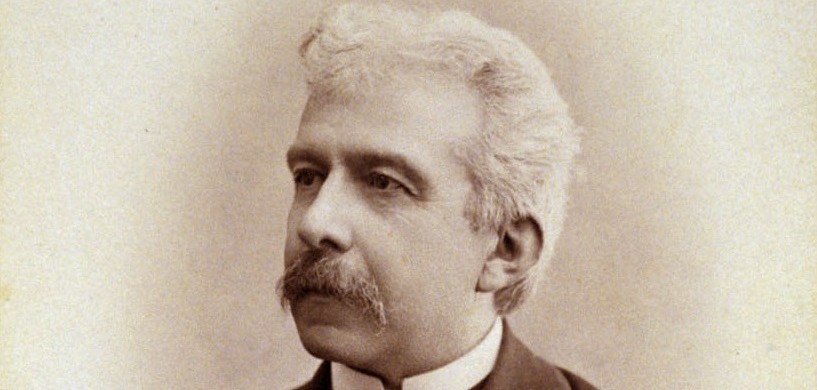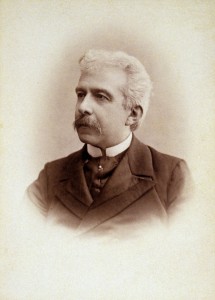Antonio Fogazzaro 1874 and 1881
The author Antonio Fogazzaro (1842–1911) was one of the most prominent authors and poets in Italy. He was several times nominated for the Nobel prize in literature. Fogazzaro studied Le Duc’s French translation of the Kalevala and he gave a lecture based on it in 1874 in the Accademia Olimpica in Vicenza. As a poet, Fogazzaro was enthusiastic about the power of the message of the Kalevala and he told his listeners about the contents of the Kalevala, the nature in Finland, the life of the ancient Finnish people, the folklore and the importance of the spells. He also presented a thorough analysis of the characters Kullervo and Lemminkäinen. The lecture was published in the journal Il Convegno and in 1901 in the book Le Minime.
Foggazzaro also translated 176 verses from the Kalevala into Italian using the French version. He used the hendecasyllabic poetic meter as well and the end rhyme that is typical for the Italian poetic language. The result was remarkably good, even though he cut some of the verses shorter and edited them. The themes in the poetic translation were the song of Louhi, who was the mother of the bride, the song of the bride, the lament and the song of advice. Fogazzaro published his translations of the Kalevala in many poem collections and in 1881 he translated 17 more verses of the song of advice (231–42 and 429–60 in the poem 22) to the Lamberti-Balbi family’s wedding book.
Väinämöinen’s maiden of sea pearls
Fogazzaro was particularly interested in the character of Väinämöinen. Fogazzaro thinks that in the poem 41, in which Väinämöinen plays the kantele and summons all the beings in the creation and is moved to tears, some of the most beautiful poetic verses ever written can be found. They depict how the tears of the singer roll down into the sea and transform into pearls. Fogazzaro was inspired by the verses and invited the listeners of his lecture to engage in the distant world where the tears of great poets turn into pearls. Väinämöinen’s poem was also the inspirational source of Fogazzaro’s short story Màlgari, la perla, which was published in 1889. The plot of the short story is as follows: The main character in the Màlgari is one of Väinämöinen’s tears that had turned into a pearl. The sea takes the pearl to Venice, where the story takes place in the 16th century. The head of the nation, Doge, finds the pearl and donates it to Contarina Contarini, who has just lost a daughter. A miracle happens. The pearl becomes a blue-eyed blonde little girl, who is named Màlgari.
Contarina had a premonition in which Màlgari was to be kept far away from music and musicians. The girl grows up and becomes a lovely maiden who falls in love with a musician from the North. However, Màlgari has to agree to marry Doge and the wedding is to be held on a Greek island. The bride departs on a ship and the musician appears one night on the deck of the ship dressed as a sailor. He starts telling the maiden about his own country.
The musician tells the maiden about Pohjola (the North), its sea which is stormy during the summer and freezes during the winter, about its inland, which is filled with birch trees, lakes and islets. The people are kind and live a humble life. The fishermen catch trout in the churning rivers. Hunters in their sleighs follow the traces of wolves, foxes and bears. There is no gold in Pohjola, but the soil is rich in the most beautiful gifts the world can give, in other words in music and poems. A magnificent epic is sung there and it tells tales of love, hate, peace and war. The folk poetry tells about an old singer and a king, who sang and cried by the sea. His tears turned into pearls and rolled into the sea.
Màlgari asks the musician to play the old poet’s melody on an Italian violin. When she hears the tunes, the maiden is deeply touched and she hides, so that no one can see her crying. When the musician starts to look for Màlgari, she is nowhere to be found. The only thing that is found is a cloth that is damp from tears. Thus, Contarina’s premonition has come true.
Who was the mystic Finnish musician in the short story? Fogazzaro offered an explanation to this. He was the ancient forefather of the folk poets Arhippa Perttunen and Ontrei Huohvanainen whom Lönnrot had met!
Vesa Matteo Piludu: “Väinämöisen kyyneleistä tuli Venetsian kaunein tyttö. Kalevala italialaisten kääntäjien ja kulttuurivaikuttajien silmin” – Kalevala maailmalla. Helsinki: SKS. 2012.

